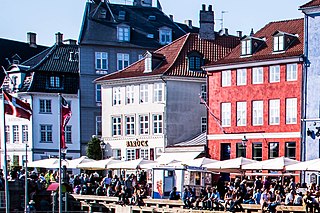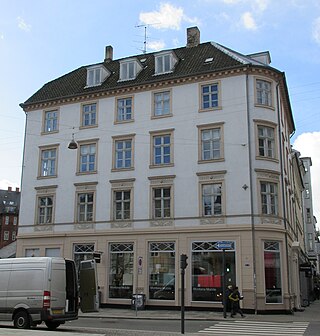
The Krak House is a Neoclassical property overlooking the square Nytorv in the Old Town of in Copenhagen, Denmark. It takes its name after the publishing house Kraks Forlag which was based there for many years. The Danish Centre for Culture and Development, a self-governing institution under the Danish Ministry of Foreign Affairs, is based in the building.

Nyhavn 1 is an 18th-century property at the acute corner of Nyhavn with Store Strandstræde in central Copenhagen, Denmark. It was listed in the Danish registry of protected buildings and places in 1987. Notable former residents include actor and singer Peter Schram (1819–1895).

Nyhavn 51 is an 18th-century canal house overlooking the Nyhavn canal in central Copenhagen, Denmark.Above the door is a painted stone relief depicting a lamb. The property was formerly known as Lammet and the sign was used for identification in a time when house numbers had still not been introduced. The letters are the initials of the builder Henrich Lambertsen Engel and his wife Karen Nielsdatter Holm. The building was listed in the Danish registry of protected buildings and places in 1918. It was subject to Schalburgtage during World War II but restored. Notable former residents include the portrait painter Hans Jørgen Hammer, the marine artist Carl Frederik Sørensen and Swedish actress Eva Eklund.

Bredgade 24 is a listed building located at the corner of Bredgade and Sankt Annæ Plads in central Copenhagen, Denmark. The building was listed on the Danish registry of protected buildings in 1987. Notable former residents include painter and photographer Niels Christian Hansen.

Gammel Strand 50 is a Neoclassical building overlooking Slotsholmens Kanal in central Copenhagen, Denmark. It was constructed as part of the rebuilding of the city following the Copenhagen Fire of 1795. The building was listed on the Danish registry of protected buildings and places in 1918. Notable former residents include the musician Holger Simon Paulli, chemist Christen Thomsen Barfoed and author Hans Vilhelm Kaalund-

Niels Hemmingsens Gade 32 is a historic building in the Old Town of Copenhagen, Denmark. It was built in the first half of the 1740s. A brewery was for more than one hundred years operated in a rear wing. Brødrene Cloëtta, one of Denmark's leading chocolate manufacturers of its day, was based in the building from 1865 until 1901. The three-winged building complex was listed on the Danish registry of protected buildings and places in 1981. A gilded Neptune figure is seen above the gateway and the keystone features the names of the first owners. Notable former residents include the naval officers Poul de Løvenørn and Peter Nicolay Skibsted, the businessman Conrad Hauser and the linguist Rasmus Rask.

Vestergade 1 is a Neoclassical property located at the corner of Gammeltorv and the street Vestergade in the Old Town of Copenhagen, Denmark. The facade towards Gammeltorv and Vestergade meet in an Obtuse angle with four bays towards the square and five bays towards the street. The building was listed in the Danish registry of protected buildings and places in 1950. Café Gammel Torv, a traditional Danish lunch restaurant, has since 1910 been based in the basement at Gammeltorv 20. The building/restaurant is now colloquially known as The House With The Green Tree after an eponymous 1942 novel by Kalvin Lindemann.

Badstuestræde 7 is a Neoclassical property situated off the shopping street Strøget in the Old Town of Copenhagen, Denmark. The building was like most of the other buildings in the street constructed in the years after the Copenhagen Fire of 1795. It was listed in the Danish registry of protected buildings and places in 1964.

Nybrogade 28 is a Late Neoclassical property overlooking Slotsholmen Canal in central Copenhagen, Denmark. The narrow property comprises the four-storey building towards Nyrbogade and another four-storey building at Magstræde 15 on the other side of the block as well as a side wing linking them together along one side of a small courtyard. The entire complex was listed in the Danish registry of protected buildings and places in 1945. The publishing house Forlaget Vandkunsten is based in the building. It also operates a literary venue in the building under the name Litteraturhuset. The activities comprise a bookshop, café and public readings, debates and other literary events.

Grøbrødretorv 4 is a mid 18th-century residential property situated on the east side of Gråbrødretorv in the Old Town of Copenhagen, Denmark. The three-winged complex was listed in the Danish registry of protected buildings and places in 1918. Former residents include the actor Dirch Passer and the artist Bjørn Wiinblad. The latter has decorated the walls of the principal staircase with a series of murals.

Gråbrødretorv 6 is a building at the corner of Gråbrødretorv and Niels Hemmingsens Gade in the Old Town of Copenhagen, Denmark. The oldest parts of the building date from the 1730s but it owes its current appearance to a reconstruction in 1818 and an adaptation undertaken by Valdemar Ingemann in 1881. It was listed in the Danish registry of protected buildings and places in 1945. Former residents include bishop Hans Lassen Martensen and businessman Jacob Heinrich Moresco.

Rådhusstræde 15 is a narrow, early 18th-century property situated on Rådhusstræde, opposite the small square Vandkunsten, in the Old Town of Copenhagen, Denmark. It was listed in the Danish registry of protected buildings and places in 1945. Dyrenes Beskyttelse, Denmark's first and largest non-profit animal welfare organization, was also based in the building in the first half of the 20th century.

Vingårdstrøde 19 is a Neoclassical property situated on Vingårdstræde, between Kongens Nytorv and Nikolaj Plads, in central Copenhagen, Denmark. Like most of the other buildings in the area, the building was constructed as part of the rebuilding of the city following the Copenhagen Fire of 1795. It was listed in the Danish registry of protected buildings and places in 1959. A number of people associated with the Royal Danish Theatre have resided in the building, including ballet dancers and choreographers Antoine Bournonville, August Bournonville and Carl Dahlén, as well as a number of members of the Royal Danish Orchestra. Other notable former residents include future cookbook writer Anne Marie Mangor, portrait painter Johan Frederik Møller and sculptor Daniel Peter Støhrmann.

Fiskebløderhuset is an 18th-century building situated at the corner of Gråbrødretorv and Niels Hemmingsens Gade in the Old Town of Copenhagen, Denmark. It was listed in the Danish registry of protected buildings and places in 1924. A fiskebløder was a special type of fishmonger, specializing in the soaking and selling of stockfish. Together with the adjacent buildings at Gråbrødretorv No. 3–9, the building is one of the best preserved examples of the so-called "fire houses" which were constructed as part of the rebuilding of the city following the Copenhagen Fire of 1728. A limestone tablet above the main entrance commemorates the fire.

Toldbodgade 5 is a 17th-century property situated in Toldbodgade, off Nyhavn in central Copenhagen, Denmark. It was listed in the Danish registry of protected buildings and places in 1977. The composer Carl Nielsen and the sculptor Anne Marie Carl-Nielsen resided in the apartment on the first floor from 1898 to 1906.

Lille Strandstræde 16 is a Neoclassical property situated on Lille Strandstræde, between Sankt Annæ Plads and Nyhavn in central Copenhagen, Denmark. The building was listed in the Danish registry of protected buildings and places in 1950.

Knabrostræde 28 is an 18th-century property situated at the corner of Knabrostræde and Magstræde, close to Gammel Strand in the Old Town of Copenhagen, Denmark. It was constructed as part of the rebuilding of the city following the Copenhagen Fire of 1728. It was listed in the Danish registry of protected buildings and places in 1945.

Sankt Annæ Gade 20–22 is a complex of Neoclassical buildings situated at the corner of Sankt Annæ Gade and Christianshavns Kanal in the Christianshavn neighborhood of central Copenhagen, Denmark. A distillery was for more than one hundred years—from at least the 1750s until at least the 1860s— operated on the site. The current complex consists of a corner building from 1804, flanked by two just two-bays-wide older buildings, both of which were adapted in connection with the construction of the corner building. The entire complex was jointly listed in the Danish registry of protected buildings and places in 1950. The courtyard on the rear was redesigned by landscape architect Jeppe Aagaard Andersen in the 1980s.

Kompagnistræde 20 is a Neoclassical building complex situated at the corner of Kompagnistræde and Knabrostræde in the Old Town of Copenhagen, Denmark, constructed in 1796–97 as part of the rebuilding of the city following the Copenhagen Fire of 1795. A brewery was for more than 200 years, from at least the late 1640s until the 1860s, operated on the site. The building complex comprises a residential corner building as well as an adjacent warehouse at Knabrostræde 16 and another warehouse in the courtyard. The entire complex was listed in the Danish registry of protected buildings and places in 1945. Notable former residents include the government official Jacob Gude, civil servant and later Minister of Interior Affairs I.J. Unsgaard and painter and photographer Edvard Valdemar Harboe.

Rosengården 13 is a mid 19th-century property situated in the street Rosengården, between Kultorvet and the shopping street Strøget, in the Old Town of Copenhagen, Denmark. The building was listed in the Danish registry of protected buildings and places in 1964. The neighboring building at Rosengården 5 was also constructed for Culmsee.




























